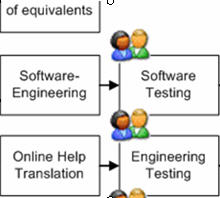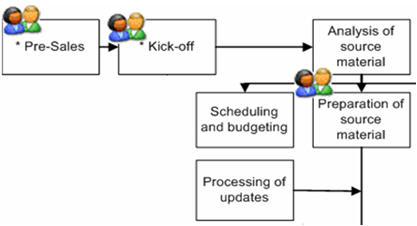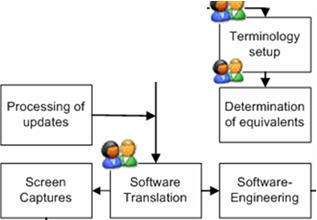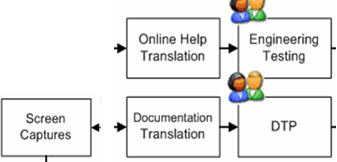In a localisation project there are several processes related to linguistics, technology and project management that should be planned and prepared before starting. As previously stated, each localisation project is unique; however, some of following processes or phases can be identified in a typical localisation project (in no particular order):

The software and test engineering process involves technical aspects of the localisation of software that should be tackled at the beginning and in the end of the localisation process. Usually, localisation engineers or testing engineers are responsible for performing the tasks in this phase. Some of these tasks are e.g.:
- Internationalisation of software: this should happen during the software development phase. It involves separating text from the software source code or enabling software to display the character sets and support the local standards of a particular language and country.
- Preparation of the project: this should happen at the beginning of a project. It has do to with checking the source material to be translated for completeness (are all files to be localised complete? are instructions included?); compiling the software (is there a special procedure needed when compiling? can controls, buttons, and dialog boxes be resized if translated text is longer than original? should locale information be changed in the resource files? (see also L10N 3 File Formats); and preparing for translation (which files need to be translated? are there existing translations that can be reused? what should not be translated? which software localisation tool should be used, if any?, should a TM be used?)
- Engineering and testing the localised software: This includes activities such as resizing the translated software user interface (buttons, dialog boxes, etc.), checking and testing unique hot keys (the underlined letter or number in a menu command or dialog box used with the Alt key), compiling the localised resource files into a running application (in the case of software or online help), as well as testing the software functionality (to make sure that the translated version of the software functions properly) and creating screenshots of the localised version, among others
- Assistance for localisation project: software engineers should help project managers, translators and localisers any time during the localisation process when there are problems concerning technical aspects
The project management process (see also eCoLoTrain PM Modul) is key in localisation and takes place from the very beginning to the very end of the whole localisation process. The specialists responsible for the PM process are the project managers, who schedule and monitor all project components and activities. Some of the activities include:
- Budgeting: In order to develop and manage a budget in a localisation project, certain factors have to be taken into consideration, for example: expected volumes and word rates for outsourced translation, resource costs (e.g. hourly rates), expected number of hours spent on each project activity, additional costs required for the project (e.g. purchase of other software, etc.), percentage of unexpected expenses (rework or higher overtime rates), etc.
- Time management: Time schedules must be created at the beginning of localisation projects. The aim is to outline the start and end dates for all activities in the project, which can be: terminology setup and glossary preparation, project setup and preparation (evaluation of source material and extraction of translatable text), translation of software and documentation, engineering and testing of software, preparing documentation layout, quality assurance and final production
- Set-up of the project: Some important steps when setting up a project are the following: organisation of a project evaluation for all project components (what needs to be localised?, what are the deliverables?), creation of a project folder for all material (storage of all project files in a central location), creation of a project schedule, creation of a project budget and a quality plan (definition of the steps for quality management), creating a communication plan (external and internal communication)
- Coordination of terminology and, if necessary, translation memories (TMs): The tasks that project managers usually perform regarding terminology involve reviewing and approving generic and product-specific terminology, preparing glossaries or terminology databases for the specific project or guiding translators in establishing terminology glossaries, evaluating terminology management and glossary tools, etc. They are also responsible for the creation or preparation of translation memories for localisation projects. Project managers should, as a general rule, provide translators with sufficient reference material such as a copy of a working software, online help or printed documentation (see next section "Translation")
- Selecting human resources and tools: Human resources (localisers, translators and collaborators) and the most appropriate translation/localisation tools must be selected for the project according to client’s requirements, type of resources, etc.
- Internal communication: Project managers should encourage internal communication so that all team members are aware of their responsibilities, the latest developments, and any changes or updates to the project
- External communication: Communication with clients must be managed. Clients need to be informed of missed deadlines, delays or other project problems. External communication with the clients may involve delivering regular status reports
- Mediation between translators and clients: Sometimes, clients allow direct communication between their development or engineering staff and the localisation staff, which must be mediated
The translation process comprises all activities related with the translation of software and documentation, as well as with the creation and maintenance of language guidelines, terminology, translation memories, etc.:
- Software translation: this involves the translation of the graphical user interface elements of software (dialog boxes, menus, error or status messages, etc.) and sample files. Software translation is usually performed using software localisation tools and/or translation memory tools.
- Documentation translation: This involves the translation of printed documentation and online documentation (online help, online manuals and websites). It is usually performed using translation memory tools and is usually the largest translation component of most localisation projects.
- Terminology work: Language specialists responsible for the terminology in a localisation project typically perform the following tasks: review and approval of generic and product specific terminology, maintenance of terminology databases, terminology research, monitoring the use of terminology tools and glossary management tools.
- Translation Memory (TMs) Maintenance: TM (see also eCoLoTrain TM Module) allows recycling or re-using translations of previous projects. Since software products are at least updated once in a year – and websites even daily.
- TM tools are very popular in the software localisation industry. When using TMs in a localisation project, there are many aspects which project managers or lead translators have to take into consideration, e.g.:
- Are the project file formats supported by the TM tool?
- Do the resource files need to be converted in order to be used with the TM tool (edition) available?
- Are TM segmentation rules appropriate for the project source files?
- What is the number of internal and external matches TM for making a cost perspective of the project?
- What is the percentage of full and fuzzy matches for pricing the project?
- Is it possible to match previously created translations by performing an alignment ?
- How will be the translation memories made available to translators server-based vs. local TMs)?
- Translation review: Depending on the localisation and translation company, the translation review process is monitored by editors or senior translators and/or proofreaders. Translations are normally edited by a senior translator or editor. Senior translators and editors are responsible of ensuring consistency in terminology and style, as well as linguistic and technical accuracy. They should have a very good understanding of the project subject matter and also fluency in the source and target language. However, proofreaders often do a linguistic quality control on the final product; this means, reading the translated texts from an end-user perspective. For more information on translation projects click here .
DTP operators are generally responsible for DTP tasks in a localisation project. To perform their tasks efficiently, DTP operators need sometimes a wide range of software applications - such as Adobe FrameMaker, QuarkXPress, Adobe Acrobat family tools, etc. Some tasks pertaining to the DTP process in the software localisation include:
- Converting DTP formats for editing within TMs: Nowadays, TM tools come with filters that allow users to work with the industry-standard file formats (HTML/SGML/XML, FrameMaker, Adobe PageMaker, Adobe InDesign, etc.). The source text for localisation is usually imported into the TM tool and exported in its original format after being translated.
- Integrating and adapting graphics and screen captures: Since graphics and screen captures are usually embedded in or linked to documentation and online help files, they also need to be localised. Usually, it is the localisation engineer (also very often the translator) who creates the new graphics or the screen captures of the localised software application and integrates them in the documentation or manuals where they have to be inserted.
- Checking layout of printed and electronic documentation: Normally, and unless otherwise specified by clients, the final layout, typographic conventions and styles of printed and electronic documentation have to match the source files. Some of the aspects which DTP operators or project managers/lead translators have to take into consideration when finalising page and paragraph formatting are: page numbering, language settings, table definitions, notes, warnings, etc. Some other elements at the text level that also should be checked, as they may be culture-specific are: font type and size, character spacing, attributes such as bold and italic and punctuation.
When talking about quality it is important to distinguish two concepts: quality assurance (QA) and quality control (QC). Quality assurance (QA) refers to the steps and processes needed to ensure a final quality product that meets the standards. Quality control (QC) is a QA subordinated process which focuses on fulfilling quality requirements – linguistic and technical steps such as revision, reviewing, proofreading and testing. Usually, project managers are the ones responsible for quality assurance (QA) and localisation companies for the quality control (QC) with respect to the functionality of the localised product. Other tasks which are also part of the QA process in localisation are:
- Internationalisation test: products should be tested before localisation to find out if they have been internationalised, in order to avoid problems during the localisation process. If this step is not done and the application have not been internationalised, the problems will have to be later on fixed for all target languages. The internationalisation test is usually performed during the development phase of the product and focuses on the language support of the application – e.g. how well are languages, regional settings (date, time and currency format) and script supported.
- Localisation test: Localisation companies are usually responsible for the localisation test. This test should be performed separately on each language version of an already localised software application, and includes in turn a linguistic test and a cosmetic test.
- Linguistic test: This test focuses on all language-related aspects of the localised application and should be performed by the localiser or translator with the help of a localisation engineer. Each menu, (dynamic) dialog box and as many strings as possible should be reviewed. Some of the issues to keep in mind when performing such a test are: Has all text been translated? Do dialog boxes and error messages display fully, without truncation? Are accented characters correctly displayed? Have icons, graphics or sound been adjusted for the target language? Do strings with variables display correctly in the running application? Are hot keys consistently assigned? etc.
- Cosmetic test: This type of test involves all visual aspects of a localised application – e.g. dialog boxes, menus, reports, and messages. Some of the aspects to consider when performing a cosmetic test are: are dialog boxes properly resized? Do all menu items, status bar messages, dialog boxes fit on the screen in all screen resolutions? Do all localised versions display the same number of menus, options and commands as the original application? etc.
- Functionality test: This refers to the actual functionality of the localised application. The program’s functionality test often reflects the testing process that should be performed on the source language product in the initial phase of the project. To perform a functionality test, translation should be finalised and stable.
(Adapted from Esselink, 2000)






